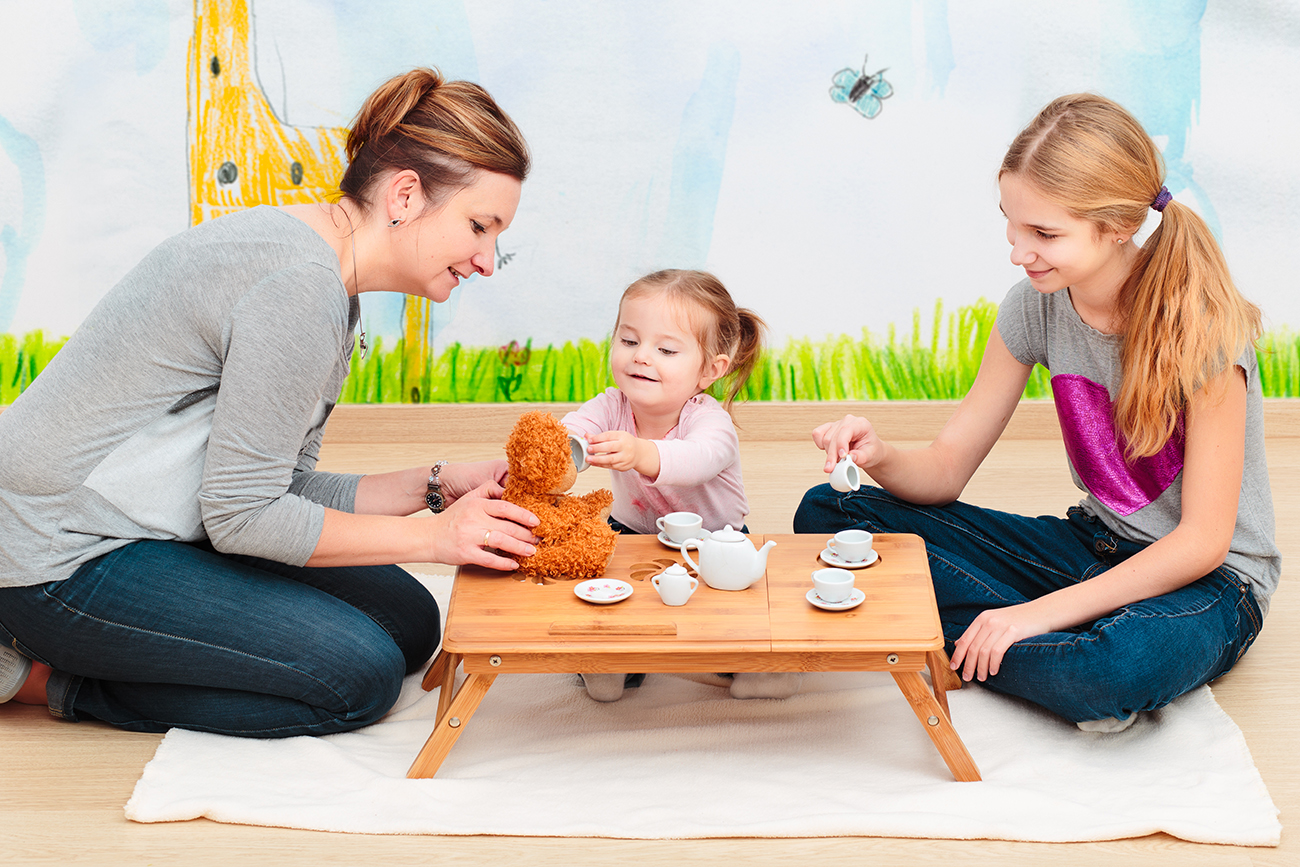Research Reveals the Power of Pretending

It's so much fun to pretend with your child! But there's a lot more to pretending than just playing around. Children learn so much when they pretend, including some important communication skills.
New research shows that parents and toddlers use specific early communication skills more often when they pretend together, compared to other types of play [1]. There are two very important early communication skills that young children practice when they pretend with their caregivers: gestures and joint attention.
Gestures
Gestures like pointing, giving objects, or shaking one’s head to say “no” provide children with a way of expressing themselves before they can use words. Using gestures to communicate, therefore, allows young children to send messages. When parents notice their child’s gestures and use language that matches these messages, it helps young children learn the words for what they are expressing without words.
Joint attention
Joint attention refers to moments when two people are paying attention to the same object or event, and they both know that they are focussed on the same thing. They use gestures and eye gaze to focus on the same thing together. For example, a boy might look at his mother, then point to an airplane flying overhead to draw her attention to it, and then look back at his mother to make sure that she is also looking at the airplane. In this way, they focus their attention on the same thing through their eye gaze and pointing. This important skill allows children to draw adults’ attention to things that interest them so they can send messages about them. Then, when adults use language to talk about the things that interest the child, he can learn the words for the things that have caught his attention.
Joint attention and gestures are key skills that allow children to progress with their language development. In fact, they lay the foundation for children's first words.
A recent study compared how often parents and their toddlers used these key skills with each other during their pretend play and their “functional play.” Functional play involves playing with toys in the way they were intended, like shaking a tambourine, putting a puzzle piece in a puzzle, or a marble in a marble ramp. When children engage in functional play, they don’t use their imagination.
The researchers found that parents and toddlers showed more joint attention and stayed in those moments for longer periods of time during pretend play. They also found that they used more gestures, especially gestures that help them pretend, such as stirring pretend food in a pot or holding up a hand to one’s ear as if talking on the phone.
Parents and toddlers show more joint attention and stay in those moments for longer periods of time during pretend play.
Why does pretend play encourage early communication?
There are a couple of reasons why pretend play might encourage parents and toddlers to use joint attention and gestures more often [1]:
- Pretend play is cooperative - caregivers and children need to work together and pay attention to each other in order to discover the meaning of each others’ pretend actions. This means that they need to watch each other carefully and focus on the same thing to figure out what the other person is doing. This might encourage joint attention.
- The meaning behind someone’s pretending is not always obvious - caregivers and children need to figure out the meaning behind each other’s pretend actions in order to play together. Since toddlers are still learning to talk, they might use gestures to demonstrate the meaning behind their pretending. For example, a toddler might hold up a toy teapot and pretend to pour, showing her mother that she wants to have a pretend tea party.
The researchers explain that pretend play involves a “cooperative meeting of the minds” [1, p. 2], which means that caregiver and child need to work together to understand each other’s actions and meaning as they play together. This creates a situation where they need to use joint attention and gestures to understand each other.
Making a case for pretend play
This new research makes a good case for giving pretend play special status when it comes to encouraging young children’s communication skills.”
All types of play are important, and children learn different things by playing in different ways. Caregivers can join in any type of play, whether it be physical games like chase, functional play like doing puzzles together, or sensory play like playing in the sand. This new research, though, makes a good case for giving pretend play special status when it comes to encouraging young children's communication skills.
Most children start pretending by 18 months of age [1]. If you think your child may be ready for pretend play, check out our article The Land of Make Believe: How and Why to Encourage Pretend Play for some strategies for making the most out of pretending with your child. Not sure which toys to use? Our article Toys that Kick Start the Imagination provides ideas about some simple toys that encourage pretending.
Have fun finding your inner child and using your imagination with your child!
For more information about how you can promote your child’s language skills, including great tips for incorporating pretend play, check out It Takes Two to Talk®: A Practical Guide for Parents of Children with Language Delays.
Similar articles by tag:
